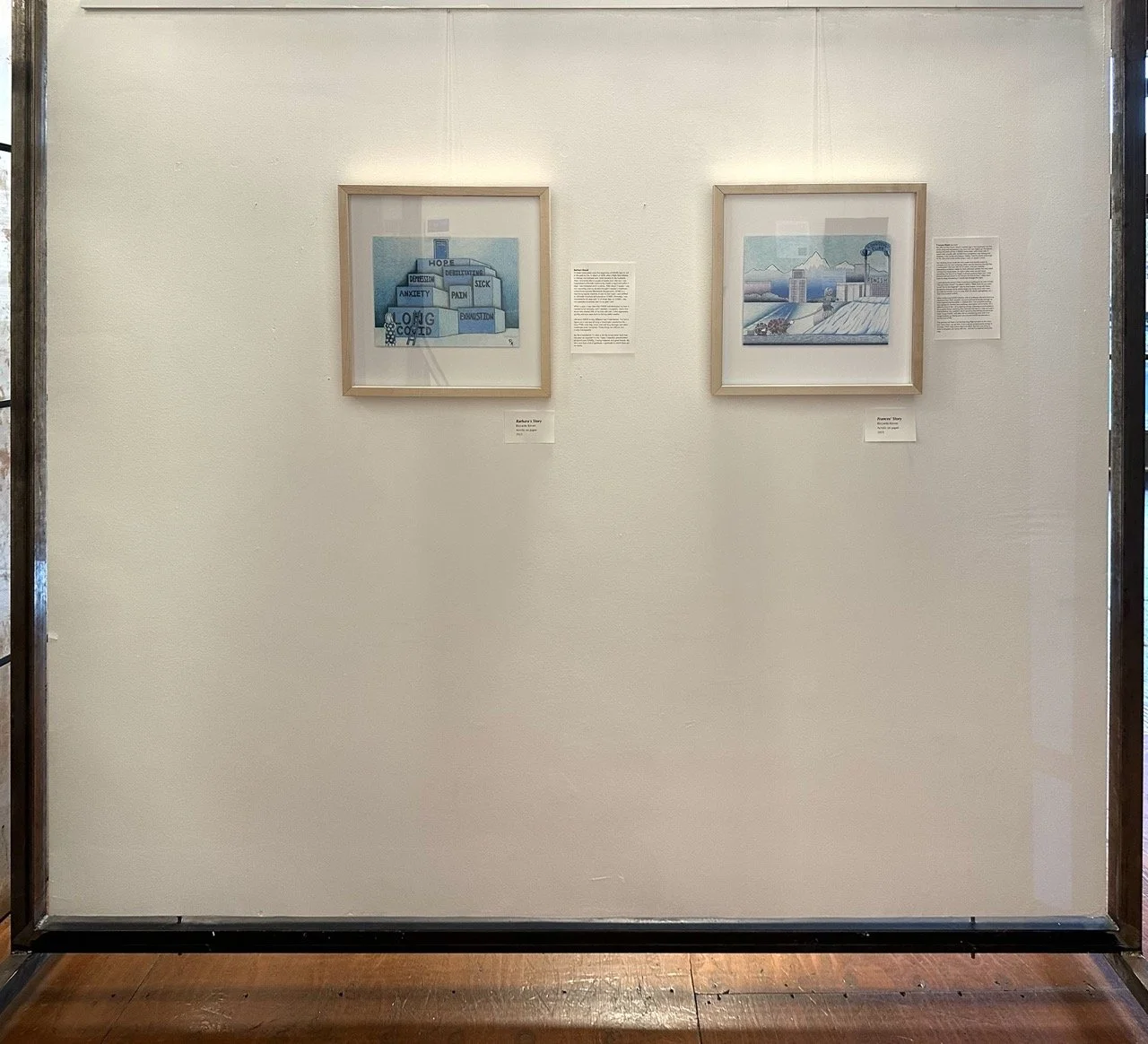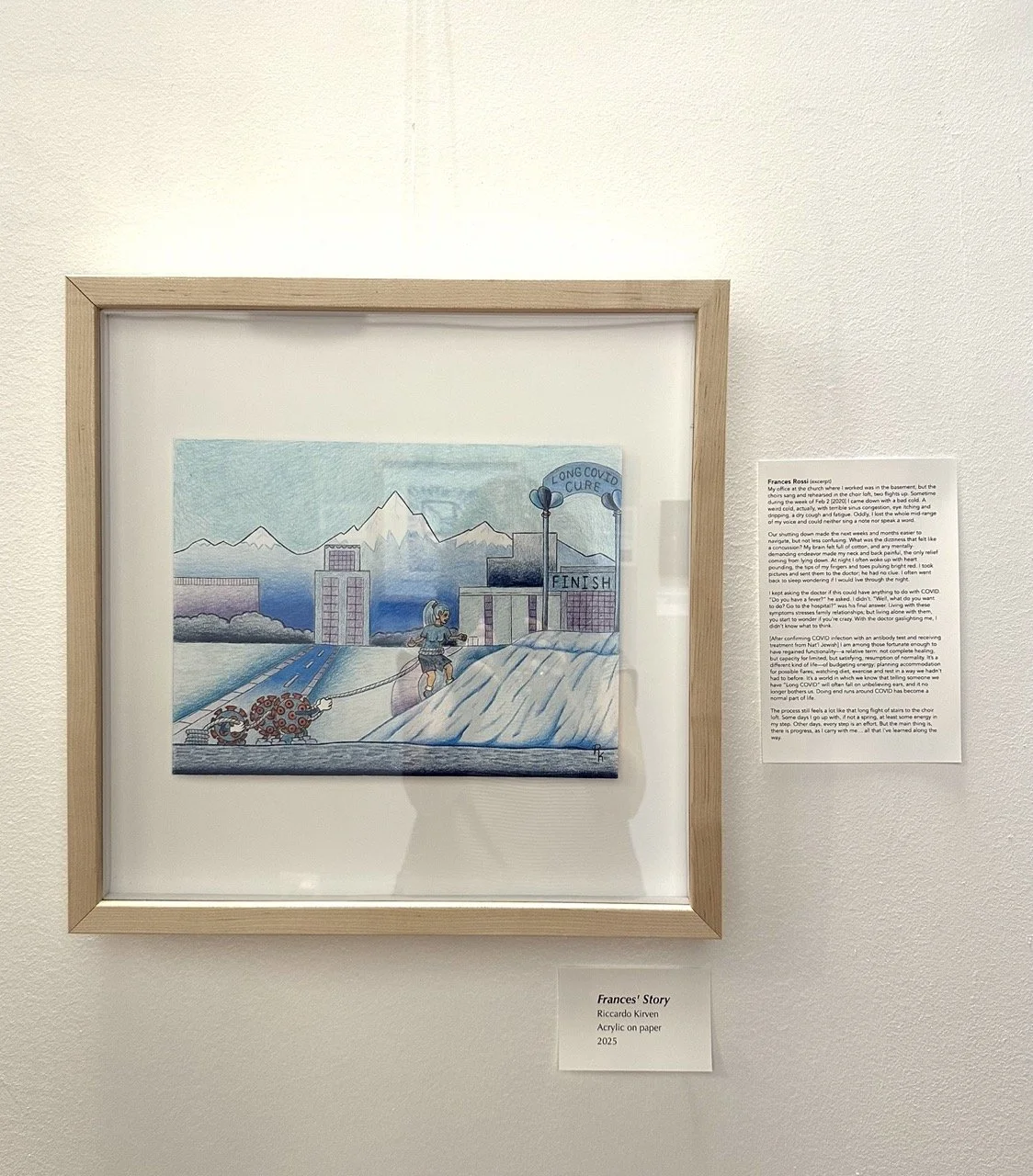Frances Rossi
Climbing the Stairs
My office at the church where I worked was in the basement, but the choirs sang and rehearsed in the choir loft, two flights up. I was on those stairs a lot in late winter 2020, with three choirs to prepare for, rehearse with and sing with over the course of the week.
In those cold months I was taking the light rail to work, sometimes both leaving and returning home in the dark. The trains were packed, so that sometimes I ended up standing; good to have so many riders, I thought.
News of the novel Sars CoV-2 virus alarmed us, but still seemed remote in early February. The train grew less crowded and I was happy to sit down. I began to think about trying to wear a mask.
Sunday morning February 2nd, we practiced in the basement as usual, the seven of us, always excited to be singing together. Right before mass we gathered our music, and I took my guitar to go up to the loft. “Need some help with that?” our tenor asked. “No, thanks, I’m fine!” I answered, mounting the stairs without hesitation.
Sometime during that week I came down with a bad cold. A weird cold, actually, with terrible sinus congestion, eye itching and dripping, a dry cough and fatigue. Oddly, I lost the whole mid-range of my voice and could neither sing a note nor speak a word.
When I showed up for choir the next Sunday, the tenor asked again: ‘Need help?” This time I did, struggling breathless with the climb.
I’d gotten past the cold more or less by the next week and returned to my rehearsal schedule—or attempted to. One day I had to call off practices due to fatigue. It seemed like a poor excuse to miss, but I just couldn’t gather the energy.
March 2nd I went for my yearly wellness check, feeling somewhat well. The fatigue was concerning, though, and I asked the doctor to check for possible causes, thinking possibly auto-immune issues. I told him about the cold. “Been to Wuhan lately?” he quipped. Chuckling politely wondered if maybe he had hit on the real culprit.
It was hard to say. I hadn’t had the classic fever, shortness of breath and lung congestion. I dismissed the idea. In any case, testing then was not readily available, so there was really no way to know. At two weeks after the fact, any test would be negative, wouldn’t it?
That afternoon I went on over to rehearse with the kids., but found myself drenched in a cold sweat, having to sit down.
One of the women in the Spanish choir lost her daughter during that time, and asked me to sing for the funeral, to be held on the 9th. Of course I would!
Meanwhile, a shutdown loomed, as more and more COVID cases began to appear. City-wide it was looking as if churches would close in the coming weeks. We questioned even having the funeral, but it had been planned so we decided to go ahead with it.
Early on the 9th I woke up with the room spinning around me, hardly able to stand up. I hung my head down over the edge of the bed, hoping to reset my inner ear, and that seemed to help. When I got up at 6, the vertigo was still there, but less. I managed to get ready to go, and made it to the church. I wasn’t in the best condition to sing, but the Ave Maria resides in my reptilian brain, so that came out okay.
Our shutting down made the next weeks and months easier to navigate, but not less confusing. What was the dizziness that felt like a concussion? Was it a different virus? My brain felt full of cotton, and any mentally-demanding endeavor made my neck and back painful, the only relief coming from lying down.
No one had any answers, but I was getting suspicious. Googling “neurological” and “COVID,” I found an NIH article from a Chinese scientist who had discovered neurological damage in some of his COVID patients.
Meanwhile, at night I often woke up with heart pounding, the tips of my fingers and toes pulsing bright red. I took pictures and sent them to the doctor; he had no clue. I often went back to sleep wondering if I would live through the night.
Other odd symptoms cropped up: I could hardly lift one leg to do simple exercises; a persistent pain developed in my groin; tightness across my bra line kept making me think my bra was too tight when I’d already discarded it. Eating made me feel bloated; my abdomen felt congested; food didn’t seem to move through the system as it should. Frequently I felt as if I were coming down with something else.
I kept asking the doctor if this could have anything to do with COVID. “Do you have a fever?” he asked. I didn’t. “Well, what do you want to do? Go to the hospital?” was his final answer. There seemed to be no alternative but to tough it out.
I did what research I could on inflammation—the cytokine storm scientists warned about. Starting a health diary, I made lists of non-inflammatory foods, anti-coagulatory foods. Because there was the clotting factor as well: my D-dimer was off the charts.
Living with these symptoms stresses family relationships; but living alone with them, you start to wonder if you’re crazy. With the doctor gas lighting me, I didn’t know what to think. There were not yet antibody tests, so I had no way to know even if that “cold” in February had actually been COVID.
In May the terms Long COVID or Long Haul COVID began to turn up in social media. I discovered the Long COVID Facebook group around that time—a turning point. Discovering others with the same symptoms as mine was validating. I no longer felt alone.
About this time UC Health developed a dependable antibody test. I got it, and the test confirmed my suspicions: I had had COVID, probably the February “cold” ; so the ongoing symptoms were consonant with those fellow sufferers knew as Long COVID.
This knowledge opened the way to take action. National Jewish Health had a Long COVID clinic, and I went there for testing and began physical therapy.
I must be a slow-learner, because it took me a while to understand why the breath therapy was important. It seemed too simple, but I practiced it. To this day I fall back on the deep breathing and the pursed-lip breathing to help me through any of a myriad of symptoms.
It seemed so complicated in the beginning, with this endless cascade of new, strange symptoms that no one could diagnose. Many seemed unrelated. Who would think a sore toe had anything to do with a chronic dry cough? What would lost sense of smell have in common with abdominal woes?
And yet, breath was key to all of this.
Although there were horror stories about choirs who spread the virus with their singing, with some members succumbing to death, singing was also key to healing.
The vagus nerve turned out to be a key player, tying together many of our symptoms. And what helps the vagus nerve? Deep breathing and humming, and singing, which combines the two.
I know that many still experience crippling effects from PASC, their lives essentially shut down for the last five years.
I am among those fortunate enough to have regained functionality—a relative term: not complete healing, but capacity for limited, but satisfying, resumption of normality. It’s a different kind of life—I think I speak for many of us here; a life of budgeting energy; planning accommodation for possible flares; watching diet, exercise and rest in a way we hadn’t had to before. It’s a world in which we know that telling someone we have “Long COVID” will often fall on unbelieving ears, and it no longer bothers us. Doing end runs around COVID has become a normal part of life.
But there are moments when I think I feel new neurons growing, when brand new thoughts pop out of nowhere and some activities actually seem easier than before. Was it a pruning of old brain cells, a necessary purging of some kind? I don’t know, but it gives me hope.
The process still feels a lot like that long flight of stairs to the choir loft. Some days I go up with, if not a spring, at least some energy in my step. Other days, every step is an effort. But the main thing is, there is progress, as I carry with me, not my guitar, but all that I’ve learned along the way.



Frances Rossi directed multiple choirs at her Catholic Church in Denver until she got Long COVID in early 2020. Through treatment and participating in research trials she has regained her ability to sing, though with thoughtful pacing. She is both a participant in and advocate for Long COVID treatment and research.
